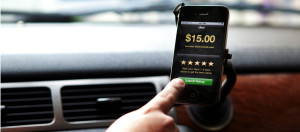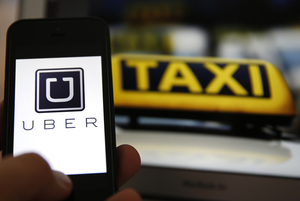Uber is well-known as a “sharing economy” success – the cab company that’s not a cab company that lives in your phone. Not content to disrupt the transportation sector, Uber is leveraging its success to muscle its way into financial services as well.
In the United States, Uber will soon begin offering drivers bank accounts and debit cards through a third-party banking partner. The partnership adds value for drivers, allowing daily instead of weekly payouts from Uber. The value for Uber presumably lies in lower fees for payment processing, and maybe a premium based on the number of new bank accounts. Mobile banking startup Clearbanc specializes in this type of disintermediation.
 Over a third of Uber’s drivers operate in the United States. While the company does not provide statistics, unbanked or underbanked individuals are likely over-represented in its workforce if the demographics are anything like those for cab drivers. Overall in the US, approximately half of unbanked individuals and two-thirds of the underbanked have access to smartphones, according to the Federal Reserve. That’s a pretty large intersection of needs.
Over a third of Uber’s drivers operate in the United States. While the company does not provide statistics, unbanked or underbanked individuals are likely over-represented in its workforce if the demographics are anything like those for cab drivers. Overall in the US, approximately half of unbanked individuals and two-thirds of the underbanked have access to smartphones, according to the Federal Reserve. That’s a pretty large intersection of needs.
In India (Uber’s second largest market), the regulatory environment is different, and adoption of mobile technology has been faster. There, Uber wants to offer drivers a mobile wallet, allowing Uber to avoid fees altogether for making payments to drivers and giving Uber custodial control over a large pool of capital.
Uber uses two tactics to gain an advantage in competing with traditional cab companies:

- Minimize regulatory exposure
- Minimize capital exposure
Uber’s approach to transportation licensing has been to dispatch drivers first and let someone else ask questions later. Asserting that Uber itself is not the service provider, the company attempts (with a great deal of success) to skirt the regulatory burdens that otherwise apply to transportation companies. The variation in existing regulations from one jurisdiction to another has left Uber with a range of requirements to deal with, some more stringent than others. But Uber rarely has to meet requirements as restrictive as those for local cab companies, and most importantly, they don’t have to meet those burdens prior to setting up shop.
 Uber’s business model minimizes the company’s capital investment in its service infrastructure. Uber does not own or maintain its fleet of vehicles for hire; those belong to the drivers. It owns very little of its own communications network; the phones that their dispatch relies on are drivers’ responsibility as well. Even the distribution of their actual product (the app) is done by third parties.
Uber’s business model minimizes the company’s capital investment in its service infrastructure. Uber does not own or maintain its fleet of vehicles for hire; those belong to the drivers. It owns very little of its own communications network; the phones that their dispatch relies on are drivers’ responsibility as well. Even the distribution of their actual product (the app) is done by third parties.
Uber is essentially an affiliate marketing program in reverse. All of Uber’s drivers are the advertisers, who share a percentage of their sales in exchange for Uber finding customers. This commission is Uber’s primary income stream, but not the only one. For years, Uber has partnered with auto dealers to offer drivers discounts on cars and car leases. Uber recently launched a new partnership program, Xchange Leasing, to offer drivers short term leases on used cars that meet Uber’s requirements.
By setting up a partnership to offer its US drivers bank accounts, Uber is simply adding another affiliate program to its revenue stream. Uber finds customers for the bank, and the bank compensates them for doing it. Partnerships with insurance companies seem like a logical next step.
In India however, Uber is jumping into financial services in a real way. By consolidating the payments channel, Uber eliminates one step in transfers and reduces their own fees. But the real change is that Uber now becomes the custodian of drivers’ money. Uber retains possession of its own payroll until drivers actually spend the money. They retain the data on spending patterns and open up doors to move into additional financial offerings of its own – with insurance again the most likely bet.
